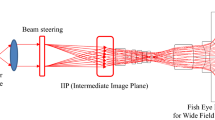Abstract
The wide spread development of electro-optical system from telecommunication to space technologies has increased the demand of customized optics. In the present work, the design of a wide-angle laser range sensor has been presented. The dependence of field of view (FOV) and active area of sensor on effective focal length of the optical system has been demonstrated. A receiving optical system is designed with a wide FOV of 40°, having detector active area of 5 mm. A good agreement is found between the realized and designed optical system. Numerical simulation has shown a strong dependence of refractive index on the performance of the system.














Similar content being viewed by others
References
T. I. Designs, TIDA-010021 Wide-range (120° FOV at 1.6 Meters) proximity sensing reference design with immunity to sunlight.
F. J. Delgado, Student Member, IEEE, J. M. Quero Senior Member, IEEE, J. Garcia, C. L. Tarrida, P. R. Ortega and S. Bermejo, Accurate and wide-field-of-view MEMS-based sun sensor for industrial applications, IEEE Trans. Ind. Electron., 59(12) Decemeber (2012), https://doi.org/10.1109/TIE.2012.2188872.
Cepton: 3D LiDAR for Smart Machines, Vista-P60, www.dataspeedinc.com/app/uploads/2019/10/Copy-of-VISTA-P60/22/11/2021.
D. Jeong, J. H. Lee, H. Jeong, C. M. Ok and H. -W. Park, Infrared dual-field-of-view optical system design with electro-optic/laser common-aperture optics, Current Optics Photonics, 2(3) June (2018) 241–24.
E. Blanquer, Laser proximity fuze–system study (2007).
R. E. Fisher, B. Tadic-Galeb and P. R. Yoder, Optical system design, 2nd edition.
J. Galbraith, Optical properties of glass: how light and glass interact. August 24, (2015).
Randal Elgin, Optical plastics, refractive index importance, August 24, (2015).
EXTECH, Raymarine, TELEDYNE FLIR E Thermal imaging temparature sensor, FLIR A35/A65.
ST-Microelectronics: VL53L5CX, Time-of-Flight 8 x 8 multi zone ranging sensor with wide field of view, DS13754-Rev 4-October (2021).
P. Bourke, Field of view and Focal length (2003).
W. J. Smith, M. C. Graw, Modern optical engineering, Hill Book Company, London, (2000) 151–152.
Sensor size and field of view, (2015)
ZEMAX Optical Design Program, ZEMAX Development Corporation.
J. Puig, C. Galland, Design of an achromatic, high numerical aperture optical assembly with a solid immersion lens, Laboratory of Quantum and Nano-optics, Institute of Physics, Ecole PolytechniqueFédérale de Lausanne (EPFL), CH-1015 Lausanne, Switzerland.
M. Siddique, Optical design of a rotating eyepiece telescope, IOP Conf. Series: Mater. Sci. Eng., 146(2016) 012004 .
Understanding Focal length and field of view.
D. Berkenfield, L. Silverman, Understanding Focal length.
Dr. R. A. Schowengerdt, Ece 425 class notes—2000, Diffraction optics.
J. A. Shaw–Montana State University, S15-(OTF) Optical Transfer Function (MTF) Modulation Transfer Function, www.montana.edu/jshaw/documents/18%20EELE582_S15_OTFMTF.pdf
Dr. R. A. Schowengerd, ECE/OPTI533 Digital image processing class notes, Optical Image Formation, (2003). www.uweb.engr.arizona.edu/~dial/ece533/notes5.pdf
https://trioptics.com/products/imagemaster-hr-tempcontrol-universal-image-quality-mtf-testing.
Trioptics: ImageMaster-HR-2016-EN-web-1/22-11-2021.
Optical design program (User's Guide). ZEMAX Development Corporation (2005).
M. Stout, B. Neff, II-VI Optical Systems, Window and Dome Technologies and Materials XV, B. J. Zelinski, Proc. SPIE 10179, 101790O, SPIE CCC code: 0277–786X/17/$18, 101790O-1, Refractive index homogeneity TWE effect on large aperture optical systems. https://doi.org/10.1117/12.2269464
M. Parry-Hill, R. T. Sutter and M. W. Davidson, Radius and refractive index effects on lens action.
A. H. Al-Hamdani and H. A. Hashim, Effect of field of view and iris pupil diameter on the quality of retinal image with allyl carbonate (CR-39) polymer contact lenses. IOP Conf. Ser.: Mater. Sci. Eng., 454(2018) 012081 .
Optical design program (User's Guide). ZEMAX Development Corporation (2005).
Author information
Authors and Affiliations
Corresponding author
Additional information
Publisher's Note
Springer Nature remains neutral with regard to jurisdictional claims in published maps and institutional affiliations.
Rights and permissions
About this article
Cite this article
Radhika, K., Babu, S.S. & Azeem, P.A. Design of Wide Angle Optical Receiver with Various Glass Materials. MAPAN 37, 329–336 (2022). https://doi.org/10.1007/s12647-022-00544-7
Received:
Accepted:
Published:
Issue Date:
DOI: https://doi.org/10.1007/s12647-022-00544-7




